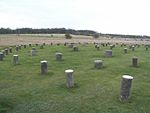Amesbury Abbey (house)
AmesburyGrade I listed buildings in WiltshireGrade I listed housesHouses completed in 1859Houses in Wiltshire ... and 1 more
Use British English from May 2021

Amesbury Abbey is a Grade I listed mansion in Amesbury, Wiltshire, England, built in the 1830s for Sir Edmund Antrobus to designs of Thomas Hopper. The house, which stands in Grade II* listed parkland, is now used as a care home. It takes its name from Amesbury Abbey, founded in about 979 on or near the same site.
Excerpt from the Wikipedia article Amesbury Abbey (house) (License: CC BY-SA 3.0, Authors, Images).Amesbury Abbey (house)
Church Lane,
Geographical coordinates (GPS) Address Nearby Places Show on map
Geographical coordinates (GPS)
| Latitude | Longitude |
|---|---|
| N 51.1745 ° | E -1.7854 ° |
Address
Church Lane
SP4 7HA , Amesbury
England, United Kingdom
Open on Google Maps








